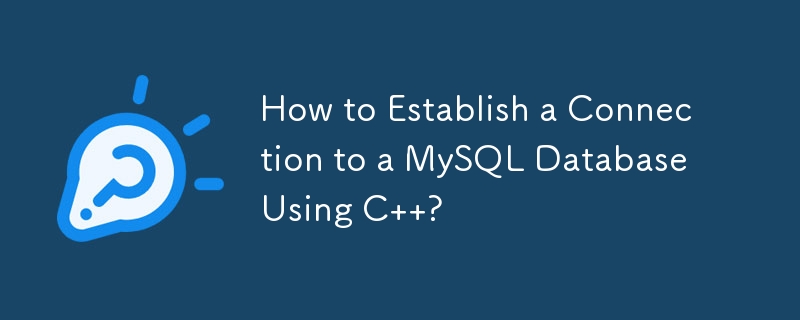

In the realm of web development, it's often necessary to access and manipulate data from a database. C provides powerful capabilities for connecting to and querying databases. In this article, we'll delve into how to establish a connection with a MySQL database using C and demonstrate the process with a practical code example.
To connect to a MySQL database, you'll need the following prerequisites:
Creating a connection to the database is the first step in accessing data. The MySQL Connector/C library provides the necessary classes and functions to establish a connection. The following code snippet demonstrates the process:
<code class="cpp">sql::Driver *driver;
sql::Connection *con;
driver = get_driver_instance();
con = driver->connect("tcp://127.0.0.1:3306", "root", "root");</code>In this code, driver is the instance of the driver class, con is the connection object, and get_driver_instance() retrieves the driver instance from the library. The connection is opened using the connect function, which takes the host, username, and password as parameters.
Once the connection is established, you can specify which database schema you want to work with. A schema is a logical collection of objects (tables, views, etc.) within a database. To set the schema, use the following code:
<code class="cpp">con->setSchema("test");</code>In this example, we're using the "test" schema, but you can change it to your desired schema name.
Now that the connection is ready, you can execute SQL queries to retrieve or update data. Here's a simple query to select data:
<code class="cpp">sql::Statement *stmt;
sql::ResultSet *res;
stmt = con->createStatement();
res = stmt->executeQuery("SELECT 'Hello World!' AS _message'");</code>In this code, stmt is a statement object used to execute queries, and res is the result set that contains the query results.
To iterate over the results and retrieve data, use the following code:
<code class="cpp">while (res->next()) {
cout << "\t... MySQL replies: ";
cout << res->getString("_message") << endl;
cout << "\t... MySQL says it again: ";
cout << res->getString(1) << endl;
}Here, the while loop iterates through the rows in the result set, and res->next() advances the cursor to the next row. res->getString() retrieves the value of the specified column (_message or column 1 in the example).
By integrating the MySQL Connector/C library and following the steps outlined above, you can seamlessly establish a connection to your MySQL database and perform data operations within your C applications. Remember to handle exceptions and close the connection objects when finished to ensure proper resource management.
The above is the detailed content of How to Establish a Connection to a MySQL Database Using C ?. For more information, please follow other related articles on the PHP Chinese website!
 What brand is Nubia mobile phone?
What brand is Nubia mobile phone?
 What does python do?
What does python do?
 How to solve the problem of black screen after turning on the computer and unable to enter the desktop
How to solve the problem of black screen after turning on the computer and unable to enter the desktop
 Usage of urlencode function
Usage of urlencode function
 Scope permission opening method
Scope permission opening method
 How to integrate idea with Tomcat
How to integrate idea with Tomcat
 What is star network topology?
What is star network topology?
 Garbled characters starting with ^quxjg$c
Garbled characters starting with ^quxjg$c




